Adrian Mourby takes us on another of his guided walks around Venice with a visit to San Polo, the cradle of the city
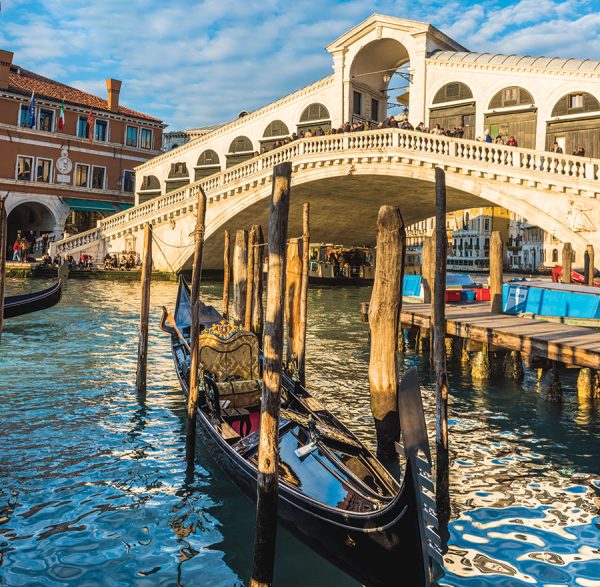
San Polo can claim to be where the modern archipelago of Venice began in the 9th century. While the administration of this great trading empire developed in the lower-lying sestiere of San Marco, San Polo remained where the international traders assembled and the Venetians shopped for fish, meat and vegetables.
Still today there is a sense that once you have crossed the bling-central shopping excesses of the Rialto Bridge that here is the ‘real’ Venice, where merchants trade and locals drink wine, and tourists are welcome, but far from essential.
There is no better place to start an exploration of San Polo than on the world-famous Ponte di Rialto. For 300 years this bridge was the only structure linking the two sides of Venice’s Grand Canal.
On the eastern side lies the sestiere of San Marco, and across this bridge, San Polo. The Venetians settled here when they moved from a more vulnerable position on the Lido in the 8th century AD. The people of the Veneti chose this site because of its quay (riva) which was high (alta).
The white arched bridge that links the two sestieri is the first stone structure to stand on this spot since the first wooden bridge was built in the 12th century. It has three parallel stone staircases with two rows of stone shops running between them.
Whereas the Ponte Vecchio in Florence reserves the river views for the back windows of all its workshops, here the pedestrians get the best sight lines, north and south along the Grand Canal.
The Rialto Bridge was first opened in 1591, meaning that when in Shakespeare’s play The Merchant of Venice (1599) Solanio asks, ‘’What news on the Rialto?’’ it is this 32-metre long, Istrian marble structure to which he is referring.
LE CORTE DEI CONTI
Stepping into San Polo, the imposing building on your right is the Corte dei Conti (the Courts of the Auditors). It was built in 1525 as the Camerlenghi Palace. This magnificent quayside palazzo is also in white marble. In Republican times, the camerlenghi were officers who managed the financial responsibilities of the state; today, the Corte dei Conti is still home to the financial magistrate of the city.
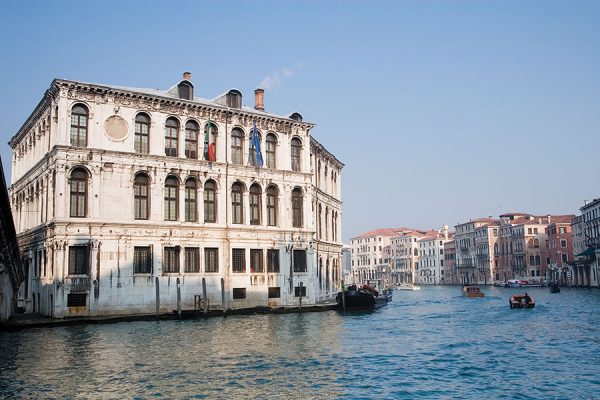
Immediately behind the Corte dei Conti is the Church of San Giacomo di Rialto, probably the oldest church in the entire city.
According to local legend it was founded in 421 AD. It is not a big church – indeed it is sometimes referred to as San Giacometto (Little Giacomo). It has a large portico for its size.
Above, its huge, beautiful white clock is notorious for not having had the correct time pretty much since its construction.
In medieval times, the markets were established in this area because it was easy for boats both from the lagoon and from the mainland to unload here. Venice’s traditional vegetable market, the Erberia, and its fish market on Campo della Pescheria still occupy the quayside north of San Giacomo.
The covered fish market, La Loggia della Pescheria di Venezia, is an imposing pseudo-Renaissance building that was constructed in the 20th century. Its columns are topped with carvings of fish, squid and fishermen.
There is also a carving of St Peter, that fisher of souls. The bounty of the Adriatic, which is laid out here daily on brightly lit wooden stalls, is enough to make anyone choose a self-catering apartment with a kitchen over hotel accommodation.
Beyond the fish market, a bridge over the Rio delle Beccarie leads to the Fondamenta della Riva dell’Ogio. The route is then forced abruptly inland. This is all the fault of the Palazzo Morosini Brandolin, which faces directly onto the Grand Canal and allows no room for pedestrians to pass by.
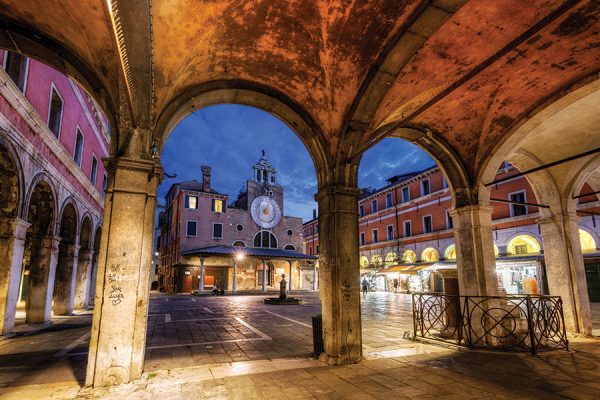
CAMPO SAN CASSIANO
The alleyway we are on now, the Calle del Campanile, heads inland to Campo San Cassiano.
Here the church of San Cassiano is crushed onto one side of the square, leaving it with an unfortunate blank exterior, overlapped by other buildings with just three bizarrely high semi-circular windows.
Its interior is baroque, with the altar framed by three Tintorettos. The altar originally displayed a Madonna by the Sicilian painter Antonello da Messina.
The 15th-century San Cassiano altarpiece was the first major example of oil painting in the city of Venice. It disappeared from the church in the 17th century and was cut into sections; the remaining pieces have since been re-united in Vienna’s Kunsthistorisches (Art History) Museum.
CAMPO SAN POLO
At Campo San Cassiano we reach the northernmost reaches of San Polo.
If you cross the bridge over Rio di San Cassiano, the black and white sign on the wall tells you that you are now in the ultimo numero of Santa Croce. From San Cassiano, a labyrinthine complex of alleyways and sottoporteghi leads west towards Campo San Polo.
It’s best to simply set your navigation app to Campo San Polo and hope that it gets a signal.
After such a confusing sequence of alleys and passageways under houses it is a relief to emerge in the Campo, which is the second biggest public space in Venice, after Piazza San Marco. There are even trees growing in it.
On its northeastern side there is a double palazzo belonging to the Soranzo family, who contributed a doge to Venice in the 14th century. The left side of the palazzo is 14th century and the right side 15th.
This later palace was originally decorated with external frescoes by Giorgione, a form of ornamentation that has wholly disappeared in Venice.
The Gritti Palace Hotel was originally one enormous fresco by Giorgione. By today’s more modest decorative standards it probably looked like a billboard.
Today the two Palazzi Soranzo make a good pair; they are painted in dull pink and privately owned, mainly as apartments and offices.
Originally, the façade of the two palaces faced a small canal, the Rio Sant’Antonio, which was paved over in 1761. They were connected to the Campo by small bridges. This removal of the canal explains why the two palazzi sit so abruptly on a public square.
In the northwest corner of Campo San Polo stands a tall palazzo that is now the offices of the Guardia di Finanza. For many years it was the home of ‘Baron Corvo’ (real name Frederick William Rolfe) an English writer whose description of the decadent doings of the 19thcentury English in Venice caused his landlady to evict him.
Tucked into the southwest corner of the campo is the Church of San Polo which has had its internal plaster hacked off to chest height because of flooding and damp and whose ceiling is cracked. However, it also contains a Last Supper by Tintoretto and a Marriage of the Virgin by Paolo Veronese.
Through a door beneath the organ loft there is a modern gallery that displays Tiepolo’s Stations of the Cross.
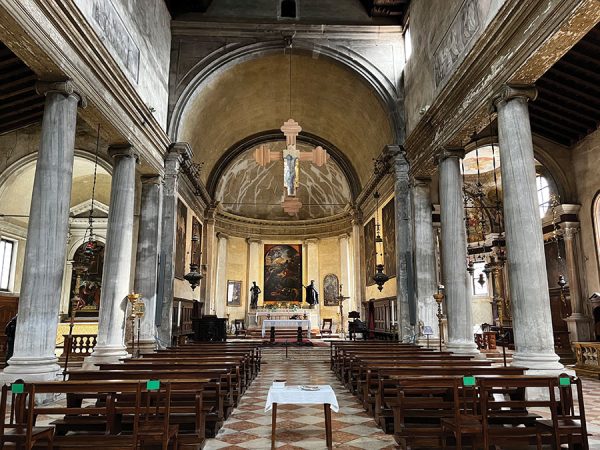
SANTA MARIA GLORIOSA
The greatest church of San Polo is still to come. Small signposts to ‘Frari’ adorn buildings once you cross Rio di San Polo.
The church of Santa Maria Gloriosa dei Frari 10 is so big and so tall it’s impossible to miss. It has its own gravitational pull. Campo Frari is big but this magnificent gothic brick structure dominates it, leaving very little oxygen for anything else.
Some of the city’s most spectacular monuments are within the church, are including Canova’s spectacular triangular tomb.
He originally designed the pyramid for Titian; his own pupils completed it to house the sculptor’s heart after his death. Titian is also buried here and commemorated in an over-elaborate 19th-century mausoleum.
Several doges have very elaborate memorials, but the tomb of the composer Monteverdi is marked by a simple inscribed white slab within a chapel. There are often flowers placed upon it by admirers.
Frari could take hours if you had the time, and a good guide, but it’s important not to miss the Scuola Grande di San Rocco, which sits on the southwestern side of Campo dei Frari, very close to the church.
The scuole (schools) were confraternities of wealthy citizens who were devoted to charity and other good works. They also found the time and resources to build themselves ostentatiously grand headquarters.
Of the six in Venice, San Rocco is the most splendid, having been designed Bartolomeo Bon and his son, Pietro Bon. It was built from 1517 to 1560 and is the only Venetian scuola not to have been destroyed by Napoleon and subsequently restored.
Downstairs, the Sala Terta is impressive, but the imagery up the gracious staircase to the Sala Superiore is remarkable even by Venetian standards. Decorated by Tintoretto between 1564 and 1587, the Sala Terra depicts scenes from the life of the Virgin Mary, including a Flight to Egypt through a verdant Italian desert.
Meanwhile, in the Sala Superiore, upstairs the ceiling is covered with scenes from the Old Testament and the walls illustrate the New Testament. Together, they show the biblical story from Fall to Redemption.
After an immersion in Venetian culture, thanks to San Polo, head towards the Grand Canal through Campo San Tomà and follow signs to the Traghetto 12 where there is a convenient €2 gondola service back to San Marco.
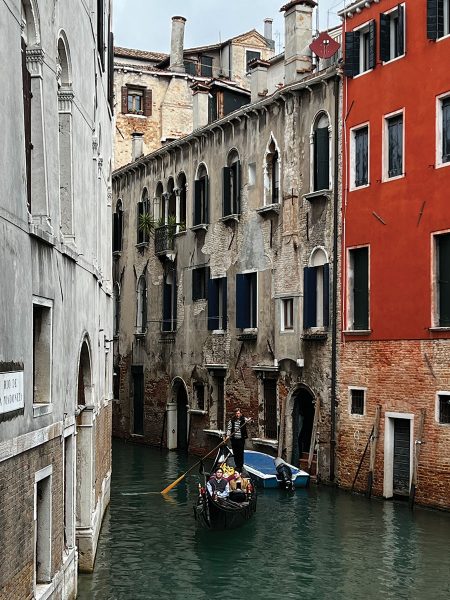
WHAT TO SEE AND DO
SANTA MARIA GLORIOSA DEI FRARI
San Polo, 3072 www.basilicadeifrari.it
This huge Franciscan monastery and church was begun in 1231 under Doge Jacopo Tiepolo. It has been through many versions since then. This brick structure added its campanile in 1396 and kept adding chapels up into the 15th century. The current façade was not completed until 1440. Today it is the most impressive basilica in Venice, with the possible exception of Zanipolo (Santi Giovanni e Paolo) in Cannaregio. Admission €3.
SCUOLA GRANDE DI SAN ROCCO
San Polo, 3054 www.scuolagrandesanrocco.org
Founded in 1478, Venice’s grandest scuola was decorated between 1564 and 1588 by Jacopo Tintoretto, who furnished the twostorey building with a cycle of 56 canvases on biblical themes. On the upper floor there is an extraordinary range of grotesque sculptures carved as ornamentation to the panelled walls, one of which is said to depict Tintoretto with his brushes. Admission €10.
THE FISH MARKET
Riva de l’Ogio, 325 San Polo
Venice’s Pescheria contains the busy indoor fish stalls of San Polo. Despite its resemblance to a Florentine loggia it was actually built in 1908 to plans by Domenico Rupolo, a neo-gothic architect who designed many villas on the Lido. The sculptures are by the painter Cesare Laurenti. Admission free.
WHERE TO EAT AND DRINK
IL MERCANTE
Fondamenta Frari, San Polo 2564 www.ilmercantevenezia.com
This trendy bar is located inside a tiny café that opened in 1870. Dainty paintings of Carnevale line the tea-room walls but by night it transforms into a heaving bar dispensing “cocktail journeys”. Each season a different explorer inspires ten new cocktails. Previous “hosts” have included Marco Polo, Ferdinand Magellan and Sir Francis Drake. Don’t arrive between 5pm and 6pm as the Mercante stops serving for an hour while it makes the transition from café to bar.
RISTORANTE CANAL GRANDE
Riva del Vin, San Polo 741 www.floridaristorazione.it
There are a number of fish restaurants along Riva del Vin, one of the most attractive embankments on the Grand Canal. The food tends to be overpriced but then you have to factor in the view: you are sitting in front of some beautiful buildings (mainly 16th to 19th century) with the sight of the Rialto Bridge, the vaporetti and the gondolas before you. With so much theatre, the food is almost an afterthought.
BIRRARIA LA CORTE
Campo San Polo, San Polo 2168 www.birrarialacorte.it
This former brewery on the San Polo’s huge Campo San Polo is a popular meeting place for students. It offers a wide range of pizza with traditional Italian mains and also beer on tap. Best of all you can sit out on the campo and see life in San Polo pass by.
WHERE TO STAY
AMAN, VENICE
Calle Giustinian, San Polo 2893 www.stay.com
One of Venice’s grandest hotels is a huge palazzo on the Grand Canal; this is where George Clooney had his wedding reception. Built as Palazzo Coccina in the 16th century, it became Palazzo Papadopoli in 1864 when it was bought by rich Greek bankers. Today the palace is owned by the Count Arrivabene Valenti Gonzaga, who lives on the top floor with his wife and children. The rooms downstairs are ornate with Tiepolo ceilings but furnished in contemporary style. The bar on the piano nobile serves a range of Byronic cocktails – Lord Byron was a near neighbour across the canal and his personality is celebrated in a range of drinks to reflect his personality: Vigorous, Lustful, Courageous, Savage, Lordly and Fascinating.
HOTEL L’OROLOGIO
Riva de l’Ogio, 1777, San Polo www.hotelorologiovenezia.com
Just behind the splendour of Venice’s fish market is an unembellished pink building that once served as police offices. Only a clockface above the main entrance announces that this is the Hotel L’Orologio, but inside there are plenty of timepieces in the low-beamed reception, and the motif continues around the hotel in a series of 43 modern, minimalist bedrooms. Many of these have Grand Canal views to the front or rooftop balconies to the rear. L’Orologio is situated close to a traghetto stop so crossing into San Marco and Cannaregio is easy and cheap.
H10 PALAZZO CANOVA
Riva del Vin, 744 San Polo www.h10hotels.com
On Riva del Vin, one of the Grand Canal’s few public embankments, Venice’s former 20th-century land registry has recently been turned into a contemporary 61-bedroom hotel. The colour scheme is bright blue and cheery yellow. There’s an internal courtyard for al fresco breakfasts and a fantastic rooftop bar with views of the Grand Canal, from Ponte de Rialto to Palazzo Mocenigo, for all-day refreshments and snacks.
GETTING THERE
British Airways flies to Venice from London Heathrow, Gatwick and City. For short stays with hotels, see BA Holidays.
Other airlines will fly you from the UK to Venice, but do note that there is a considerable difference between Venice Marco Polo and Venice Treviso.
For more travel blogs, visit our archive.
